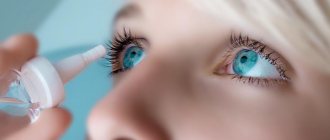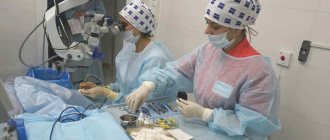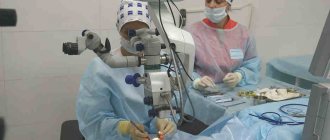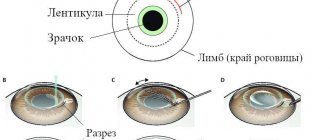Laser vision correction is a very popular modern way to restore visual function, improve the acuity and quality of vision and finally see the world clearly and in all colors. Many people are so excited about the prospect of seeing well that they forget to learn about possible complications and consequences, and are surprised when the quality of vision does not reach the level that was planned. What to do if after laser correction one eye sees poorly?
Share
Tweet
Share
Cool
Send
What is laser vision correction?
Several decades ago, there were more ways to correct vision. Lifelong wearing of glasses was replaced by surgical operations, and later by contact lenses. Laser correction, which was first performed in 1986, became a real ophthalmological discovery.
REFERENCE! Indications for LKZ are myopia, farsightedness and astigmatism.
During the procedure, a specialist uses a laser to change the curvature of the cornea without penetrating into the deeper layers of the eye, thereby improving image clarity and quality of vision.
Methods have developed, improved and new ones have appeared: less traumatic, which do not require a long recovery period and allow you to return to your normal lifestyle the next day after surgery.
Photorefractive keratectomy (PRK)
PRK is the first method of laser vision correction. Currently, this method is rarely used and is considered obsolete.
Expert opinion
Slonimsky Mikhail Germanovich
Ophthalmologist of the highest qualification category. Has extensive experience in diagnosing and treating eye diseases in adults and children. More than 20 years of experience.
The essence of PRK is as follows: the surgeon, after applying local anesthesia, separates the surface layer of the cornea using a special spatula. Then an excimer laser is used, which allows you to “polish” the cornea, removing cells layer by layer until the desired curvature is achieved. This effect is achieved due to the ability of the laser to evaporate water from the corneal cells.
The operation itself takes several hours, the rehabilitation period with pain lasts 2-3 days, after which the person recovers for at least 1 month.
Lasik
The most popular vision correction method today is called Lasik. The peculiarity of the operation is that the top layer of the cornea is also removed using a laser, which significantly reduces trauma and shortens the recovery period. After moving the surface layer, the surgeon gives the cornea the desired curvature and returns the primary flap to its place.
After this intervention, the person recovers within a few days. However, the method continues to improve and even less traumatic varieties appear.
Possible complications after surgery
Laser vision correction promises good prospects, and in most cases the person returns to ideal or near-ideal vision very quickly. The operation lasts several hours, the recovery period does not exceed 2-3 days, and after correction, as a rule, wearing glasses or contact lenses is not required.
Like any medical intervention, LKZ has its contraindications, as well as the likelihood of risks and complications. After a full examination, the specialist should talk about the possible unpleasant consequences of the operation and warn the patient that it is not always possible to achieve the desired effect.
REFERENCE! According to statistics, complications occur in no more than 2.5% of cases.
Due to poor quality equipment or unqualified specialist
Complications caused by this cause occur in approximately 27% of cases of all unpleasant consequences. As a rule, this happens if a person is not interested in the doctor’s experience or is trying to save on surgery.
What can go wrong after laser vision correction and how to avoid negative consequences
We know why you are here. You came to be afraid.
In fact, what people fear most is the unknown - that's why we talk here about everything related to laser vision correction. So you can weigh the pros and cons and make a decision with all the cards in your hand.
So, today we’ll talk about what can go wrong after laser correction.
Consequences of laser vision correction: return of myopia
It’s not scary if your vision deteriorates a little - you can always make additional correction.
The most important consequence after laser correction is that myopia may return. Why is this happening? There are two main reasons:
- Staying in the sun without sunglasses.
- In women in the postpartum period - since during the pushing period the membranes of the eye may weaken, and the eye may enlarge by fractions of millimeters, then myopia will return.
In both cases, if the thickness of the cornea allows, additional correction can be made.
Here we need to make a small digression and talk about the thickness of the cornea. The cornea is usually half a millimeter thick. There is a so-called residual value - that is, a margin beyond which the laser cannot evaporate the cornea during surgery. This thickness is calculated automatically, it is built into the laser and taken into account by surgeons. If the depth of evaporation to be produced by the laser shows that the residual value is less than normal, the laser will not allow the procedure to be completed.
Roughly speaking, no one will cut off more from the cornea than necessary, even during additional correction.
Another possible consequence of laser correction is retinal thinning
Nearsightedness (myopia) is a condition in which the eye is enlarged in size. Normally, the eye is about 23 mm; in nearsighted people it is longer. This affects the retina - it becomes thinner at the places where it is attached. Regardless of whether the patient undergoes surgery or not, he needs to undergo an annual examination of the fundus - that is, the periphery of the retina. Before correction, this examination is also carried out as part of a comprehensive diagnosis.
At the slightest sign of deterioration, surgeons recommend strengthening the retina. What could go wrong if you don't do this? Retinal detachment may begin. And this can lead to loss of vision.
How to avoid this? Undergo regular examinations by doctors, and for people with myopia, additionally undergo a fundus examination.
Side effects after laser correction or the effect of new vision?
Many people worry about night vision after surgery. Indeed, many experience a halo effect - this is the effect of light scattering due to the fact that light is refracted in different ways.
At night, a halo effect may appear. But modern technology will help fix this.
How does this happen:
The pupil dilates in the dark, allowing more light to enter. If the cornea diameter is 12 mm, laser evaporation occurs in the so-called optical zone, and its diameter is 9 mm. That is, light refraction may appear at the border of the operated and non-operated area, so vision may deteriorate at night, and a halo appears.
How is this leveled out? Modern technologies. Previously, in the late 90s - early 2000s, the laser exposure zone was 6 mm. Now this figure is no less than 8.5. Lasers continue to be improved to minimize these effects.
How different techniques affect the side effects of laser correction
The cornea has the shape of a sphere. It is necessary to create a corneal flap with a laser, a kind of lid that bends and opens access to the cornea. You can form it in different ways. In the standard LASIK procedure, the flap is created using a microkeratome. It does not perfectly follow the spherical shape of the cornea.
The microkeratome is placed on the eye, the cornea is slightly flattened, and the microkeratome cuts it off. As a result, the flap turns out to be slightly uneven; these unevennesses are measured in microns. And the more modern femtosecond laser perfectly follows the rounded shape of the cornea, and this reduces the effects of night vision deterioration.
Complications after LASIK vision correction
The most serious complication is induced keratoconus. This is a progressive thinning of the cornea. This is due to the fact that for certain reasons the cornea protrudes, and its frame begins to thin.
The good news is that keratoconus can now be predicted. At each examination, screening is performed to exclude keratoconus, which may not be acquired, but genetically determined. In this case, unfortunately, laser vision correction cannot be done due to possible consequences.
How to avoid consequences and complications after laser vision correction
- Immediately after surgery - avoid an inflammatory reaction. After the operation, the flap is very well fused to the cornea, but impacts and injuries to the eye must be avoided. And wear sunglasses.
- During the first three months , there may be dry eye syndrome, since during the operation the nerve fibers and tear film evaporate, after which they gradually begin to recover. And since there are no connections yet, a person may not feel enough that the eye is drying, so it is better to protect them from dust and try not to catch a cold. A mandatory requirement is to instill tear substitutes without preservatives.
If you have any doubts or questions, sign up for a consultation! We will discuss, tell and advise.
Long-term consequences
Long-term consequences are those that occur 3 or more years after surgery. Doctors cannot accurately determine the cause of these complications and identify the 2 most likely:
- medical errors or incorrectly performed surgery;
- characteristics of the body;
- non-compliance with doctor's recommendations and poor lifestyle.
If long-term consequences appear, most experts recommend repeated vision correction.
One eye sees worse than the other
Most often, this complication occurs when before the operation there was a difference in the diopters of the two eyes. Sometimes it happens that visual acuity changes several times a day, which significantly worsens a person’s quality of life. This condition may persist for six months after surgery.
Causes of this condition:
- postoperative swelling;
- spasm of the eye muscles;
- insufficient correction and persistence of residual myopia;
- hypercorrection;
- displacement or incorrect installation of the corneal flap;
- inflammation of the cornea due to injury or infection.
If a person after LKZ notes that one eye sees worse than the other, a thorough diagnosis is carried out and repeated vision correction is prescribed. Between the first and repeat surgery, at least 1-2 months usually pass.
What to do if this happens?
When a person decides to undergo laser vision correction, he usually imagines in advance how he will soon become the owner of ideal vision. When the results do not meet expectations, disappointment and panic sets in about what to do next.
The procedure to follow if complications arise is as follows:
- Contact your doctor and describe your symptoms in detail.
- Get advice and recommendations.
- Strictly follow all doctor's instructions.
After laser vision correction, the patient must visit the doctor for examination according to the established schedule. An unscheduled visit must be carried out in the following cases:
- severe, ongoing pain;
- tearfulness;
- burning and itching;
- pain and discomfort when blinking or moving the eyes;
- no improvement or deterioration of vision;
- severe swelling and redness;
- sudden loss of vision.
The ophthalmologist must determine the cause of the discomfort or unsatisfactory result: it could be either improper care and non-compliance with recommendations, or an incorrectly performed operation.
Further course of action:
- lifestyle changes (refusal of physical activity, normalization of diet, wearing sunglasses);
- drug treatment (use of eye drops and gels, taking vitamins);
- repeated vision correction.
In some cases, after following the doctor’s recommendations, the condition returns to normal; sometimes additional treatment with pharmaceuticals is required. If no improvement is observed, another operation is prescribed, but this does not guarantee a 100% result. Therefore, when deciding on LKZ, you need to take into account all the risks that the doctor should warn you about.
Useful video
Reminder for those preparing for LASIK surgery:
Double vision after surgery. Is this normal?
During the first three days after laser vision correction, the patient may see a blurred or double image. In most cases, this effect disappears within the next few days after the operation, but it can also “accompany” the patient for quite a long time. Doctors note that such a reaction is absolutely normal, but only if you see double for a short time. This can be especially pronounced when there is insufficient lighting, for example, when working at a desk lamp, as well as under unfavorable weather conditions.
Typically, patients complain to their doctors about the appearance of halos around the object they see or double image. Moreover, such defects do not depend in any way on the time of day, that is, they can appear both during the day and in the evening.











